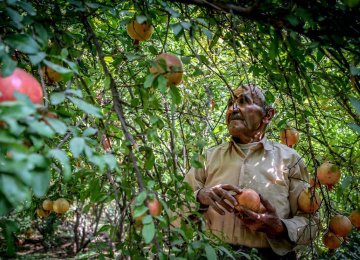Eating more fruit and vegetables can substantially increase people’s happiness levels later, a new study has claimed.
The study is one of the first major scientific attempts to explore psychological well-being beyond the traditional finding that fruit and vegetables can reduce risk of cancer and heart attacks, researchers said, NDTV reported.
Happiness benefits were detected for each extra daily portion of fruit and vegetables up to 8 portions per day. Researchers found that people who changed from almost no fruit and vegetable to eight portions of fruit and vegetable a day would experience an increase in life satisfaction equivalent to moving from unemployment to employment. The well-being improvements occurred within 24 months.
“Eating fruit and vegetables apparently boosts our happiness far more quickly than it improves human health,” said Andrew Oswald from University of Warwick in the UK.
“People’s motivation to eat healthy food is weakened by the fact that physical-health benefits, such as protecting against cancer, accrue decades later. However, well-being improvements from increased consumption of fruit and vegetables are closer to immediate,” said Oswald.
The study followed more than 12,000 randomly selected people. These subjects kept food diaries and had their psychological well-being measured.
Researchers found large positive psychological benefits within two years of an improved diet.
“Perhaps our results will be more effective than traditional messages in convincing people to have a healthy diet,” said RedzoMujcic from University of Queensland in Australia.
“There is a psychological payoff now from fruit and vegetables - not just a lower health risk decades later,” said Mujcic.
Consumption Patternsin Iran
Iran is known for its vast farm and fruit produce. A bowl of fresh fruit is common on most Persian tables andsalads and herbs like parsley, sage, rosemary and thyme are standard sides to most meals.
Iranians eat two times more fruits and vegetables than people in other developing countries and therefore the country “is in good condition in terms of food and vegetable consumption,” claims head of Iran’s Food and Drug Administration,RasoulDinarvand.
Currently, the annual per capita consumption of fruits in Iran is 134 kg which is very close to the World Health Organization’s recommended standard of 146 kg (for a person of healthy body weight consuming approximately 2000 calories per day).
However, more efforts are needed to increase the consumption of vegetables. Iranians eat 23 kg of poultry meat annually, 13 kg more than the world’s per capita consumption. They also consume 11 kg red meat which is 1 kg less than the world per capita consumption of red meat.
In a sample study of nearly 4,000 Iranian adult participants some years ago, patterns of fruit and vegetable consumption were assessed using the WHO STEP-wise method (a simple, standardized method for collecting, analyzing and disseminating data in WHO member countries).Low consumption was defined as intake of less than five servings daily of fruit and vegetables according to the WHO guidelines. On average, 1•26 servings of fruit and 1•32 servings of vegetables were consumed daily it was found.
Taken together, Iranian adults consumed 2•58 servings per day, with women consuming more than men. There was a trend towards lower consumption rates in older-age categories. Prevalence of low fruit and vegetable intake (less than five servings daily) was 87.5 % and also tended to be higher among the elderly, the study found.
Prevalence of low intake did not differ significantly among men and women or urban and rural areas.
Top in Fruit Production
It should bepointed out that Iran ranks 1st in fruit production in the Middle East and North Africaand has been ranked between 8th and 10th in global fruit production in different years.
Nearly 2.7 million hectares of orchards are harvested in the country with an annual production of over 16.5 million tons. Per capita global production of fruit is 80 kg while in Iran it is 200 kg according to the Food and Agricultural Organization statistics.
The country is famous for its production of Persian walnut, melon, tangerine, citrus fruits, kiwifruit, dates, cherries, pomegranate, peach, oranges and raisins.
A number of fruits have originated in Iran, including Persian walnuts, muskmelons, limes, and pomegranates, apple, apricot, grape, fig, citron, and many more.
Fifty different kinds of fruit are grown in the country which is blessed with favorable climatic conditions suitable for fruit production. The northern seaside lands of the Caspian Sea are known to have the best conditions for citrus fruit production.
Iran also ranks 1st in the world in the production of pomegranates, 2nd in dates, 3rd in figsand cherries and7th in grapes and oranges. The record for pomegranate production is 100 tons per hectare, 146 ton for apples and 70 tons for oranges.
With all these bounties it should not be difficult for health policymakers to develop specific plans to guide and encourage people to have a regular healthy diet through adequate intake of fruits and vegetables.





